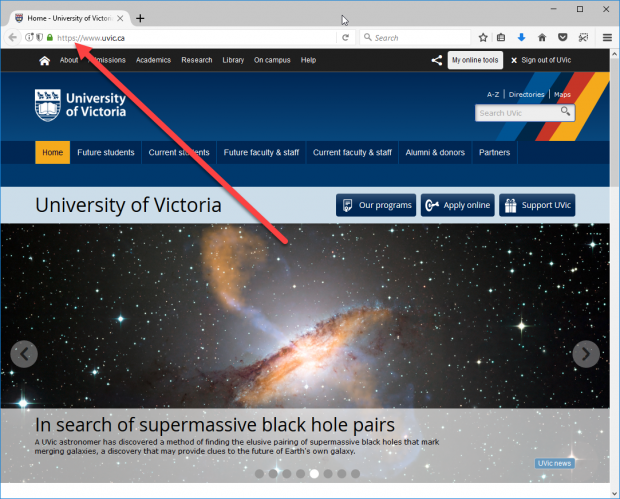The last time you brought up a www.uvic.ca webpage in your browser, you may not have noticed an additional ‘s’ in the URL location bar, but that ‘s’ means that your session with the UVic.ca website is hidden from prying eyes.
The web works on the Hyper Text Transfer Protocol (HTTP), a ‘protocol’ (or language) that servers and browsers speak to move data across the internet to your desktop, tablet or phone web browser. HTTP Secure (HTTPS) uses ‘Transport Layer Security’ to do the same thing, with the bonus that the data moving back-and-forth is encrypted along the way, preventing eavesdropping by nefarious individuals interested in your information.
 Moreover, the server certificate that enables HTTPS also certifies the ownership of the website you’re viewing. In other words, our certificate authority has verified that www.uvic.ca does in fact belong to the University Of Victoria.
Moreover, the server certificate that enables HTTPS also certifies the ownership of the website you’re viewing. In other words, our certificate authority has verified that www.uvic.ca does in fact belong to the University Of Victoria.
Technology companies have become increasingly sensitive to risks posed by private information moving across the web. In the next release of Google’s Chrome browser, security warnings will appear for all pages with forms that are delivered using HTTP (the insecure protocol). Such warnings disappear when traffic is instead encrypted with HTTPS.
University Systems recently updated traffic on www.uvic.ca to require HTTPS to ensure that traffic between you and the UVic servers is encrypted. Apart from that little ‘s’ in your location bar, you should not have noticed a difference, but your information is much more secure.
The work to force HTTPS on all www.uvic.ca traffic required coordinated efforts from University Communications + Marketing, Network Services, Production & Technical Support and Development Services.
Learn more about keeping your information private and secure on the Systems website. Take advantage of Phishing Awareness Training to learn about to protect yourself from increasingly sophisticated tactics used by criminals interested in your information (and others’ information that you have access to).
